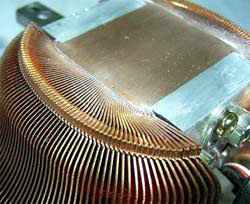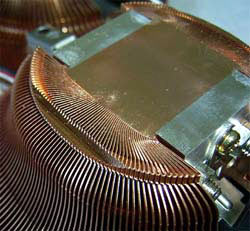Zalman 7000A Cooler Review

Late in March this year we tested the Zalman 7000Cu cooler that is aimed at mainly the Intel processors. Besides, the cooler came bundled with an attachment for Athlon 64 processors, but AMD deferred the release date for the processors till September. Therefore, the cooler was tested only on the Pentium4 processor.
Indeed, the Zalman 7000Cu showed excellent results: very effective cooling under low noise levels. At the minimum speed, the cooler runs absolutely quiet (as the manufacturer claims, the noise level is as low as 20 dBa). But that cooler had one severe flaw - there was no fastening for SocketA processors in the package bundle.
Interestingly, among the great number tested coolers for the SocketA platform there is no one balanced for either the cooling ability or the noise level. All the coolers presented on the market are biased towards either the maximum cooling or to the minimum noise level (thus to the prejudice of cooling). The most characteristic devices of the first series are Thermaltake Volcano 7+ and Titan CU5TB, and among the quietest coolers are those of the Zalman 30006000, Igloo Silent Breeze series and Titan TTC-D5TB(TC). Of course, owners of the former suffered from noise, but were able overclocking the processor, while the latter coolers - vise versa :).
There came up some skilled craftsmen who did a cross-breeding of various coolers and produced an acceptable result, but let me remind it there was no ready-made cooler featuring a quiet/noiseless fan with a high-quality radiator on sale.
Igloo Silent Breeze proved to be really noiseless, but it didn't work for overclocking processors of clock speeds higher than 2 GHz with the raise of the Vcore voltage. The CoolerMaster Aero7, could have improved the situation, upon which I built much hope. However, at the maximum speed it was roaring immensely to an unbearable level, and at the minimum speed the noise was thus low (albeit it was there), but that was to the prejudice of the cooling.
In the end, I was about to bury the hope to find the best air cooler for the SocketA, but that time Zalman announced CNPS7000A coolers. Two models were brought to the public judgment: one with a full copper radiator (-Cu) and the other with a combined aluminum-copper radiator (-AlCu). Fortunately, we managed to get both coolers.
Let's start the review with the more expensive model - 7000A-Cu.
Inside the box, we found the following contents:
- Zalman 7000A-Cu cooler
- Fastening for Pentium4 motherboards
- Fastening for Athlon 64 motherboards (including a strengthening plate *)
- * Fastening for Athlon XP (SocketA) motherboards
- A tub of proprietary thermo paste
- FanMate, a device for controlling the rotational speed
- Installation manual
- * Zalman corporate logo sticker
- A pack of silica gel (to prevent from misting under temperature differences :)
* - differences from the package bundle of the CNPS7000 cooler
All in all, the changes are about adding a pack of fastening for the SocketA platform. Inside the pack of fastening for the Socket754, a metal frame for the reverse side of the motherboard was added. Just another addition - a Zalman corporate logo sticker :))
Note that the design of the CNPS7000A cooler has practically no distinctions from the predecessor (CNPS7000).
The only distinction is the shape of the base:
 CNPS7000 -Cu
CNPS7000 -Cu
 CNPS7000A -Cu
CNPS7000A -Cu
As a result, we won't dwell on the installation of the cooler on a Socket 478 motherboard, but move straight on to the installation on the SocketA. The fastening is very simple - two metal pads that are fastened to the motherboard with screws. For that, there are four assembly holes around the processor socket. Example:
From the reverse side, it looks like this:
To prevent the screws from damaging the motherboard surface, special spacers are put on them.
Immediately, the following thoughts came up:
- The mass of the 7000A-Cu cooler is 773 g. That is too much since as per AMD specifications the cooler mass should not exceed 300 g. Clearly, it would be inadequate to fasten such a cooler to the socket teeth, so the only right way of fastening is through the assembly holes.
- In my view, a strengthening plate put on the reverse side of the board could be of good use for fastening the cooler on the SocketA. This could have helped distribute the load from the cooler more smoothly. Actually, one plate for Athlon 64 motherboards is already there in the bundle - a universal one could have been added.
- Now the most important part - almost all the motherboard manufacturers have sharply reduced the number of models having assembly holes. As a result, you simply won't be able to put coolers of the Zalman7000A series on most SocketA motherboards. Here are some examples: almost all the motherboards by Gigabyte, MSI and Elitegroup lack the mentioned holes (I mean of course boards based on up-to-date chipsets). Besides, second-rank manufacturers have also ceased to make assembly holes. For instance, all the boards by Soltek and Jetway, as well as many boards by other companies lack such holes. Even one of the earliest revisions of Abit NF7(-S) was also produced without assembly holes (but they were back on track in revisions 1.2 and 2.0 :).
- To the credit of marketing people at Zalman, they didn't make it a secret that most motherboards would be incompatible with new coolers. On the contrary, they did a series of compatibility tests and posted the results for public awareness (there is some inaccuracy in the list though :). What's more, engineers at Zalman investigated compatibility of the new cooler to various types of housings. The thing is in some configurations (motherboard + housing) the processor socket is very close to the power supply unit. That makes the Zalman 7000A cooler either rest against the power supply unit or simply impossible to install.
- Lastly, there were some difficulties coming up in choosing the right motherboard on which these coolers could be tested. Besides the assembly holes, the board should present the user information on the real core temperature. I immediately recalled the Epox 8K3A (KT333) motherboard, but then changed my mind: I was into doing tests on an up-to-date motherboard built on the nForce II chipset. But among these, only three display the core temperature: these are Asus A7N8X rev2.0, Gigabyte 7NNXP and Soltek 75FRN2-L. The last two lack assembly holes - only the Asus board stays.
That is, already upon the first look you can arrive at the conclusion that the application area for Zalman 7000A on the Socket462 platform will be very much restricted. Anyway, this fact will have little effect on the popularity of the product - this cooler can be installed on systems using Pentium4 and AMD Athlon 64 processors.
Going on with the installation - once the metal pads are installed on the motherboard, we cautiously place the cooler on the processor and tighten the screws on the clip.
The cooler is fastened with two screws - you have to tighten them very carefully and uniformly. The thing is, the Athlon XP has the open core and unless the screws are tightened uniformly, the radiator may warp, which may result in the chipping of the processor core.
Another fine point: to prevent the radiator from warping, there are 4 rubber gaskets on any SocketA processors. In fact, the Zalman 7000A fits incompletely on these gaskets. Basically, it's not a big deal; besides, the rubber gaskets can be torn off and glued closer to the radiator (which I didn't).
That's it - the installation is complete.
As regards the Zalman 7000A-AlCu cooler, we'll dwell on it in our next roundup on SocketA coolers. Now, a few photos to look at:
The only thing to note is the AlCu model is much lighter: merely 445 g, which makes it possible to carry the CPU unit around with the cooler fitted inside. But it's not recommended to carry a PC with the pure copper cooler inside. There is even a notice regarding that in the user's manual.
There is a separate mention saying that Zalman would not be responsible for any damages: mechanical or those related to overclocking.
Sure, the 7000A-AlCu costs less than the pure copper model. Therefore, it will certainly find its buyer.
Now the technical characteristics of the cooler:
- Total surface area 3170 sq.cm.
- Fan's rotational speed variable within 1350 to 2500 rpm.
- Noise levels variable within 20 dBa to 25 dBa
To adjust the speeds, there is the FanMate1 device that is available in the bundle.
Next 
 |
Content: |
 |
|
- Design
-
Performance and conclusions
 |
Top Stories: |
 |
 |
 |
MoBo:


|
 |
 |
 |
VGA Card:


|
 |
 |
 |
CPU & Memory:

|
|
|
